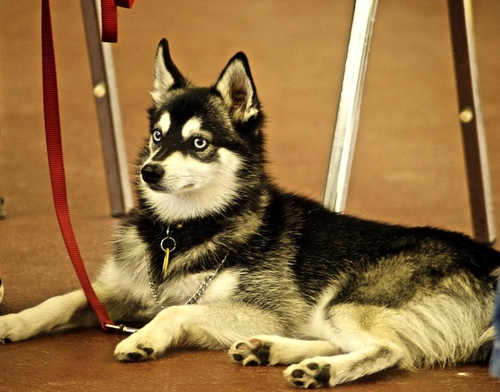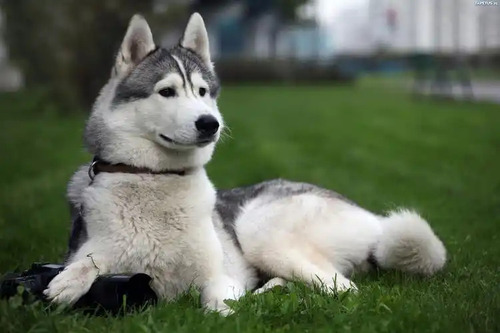When people think of northern dog breeds, the Siberian Husky often comes to mind with its wolf-like appearance and energetic personality. However, there is another lesser-known breed that resembles the Husky but in a smaller package—the Alaskan Klee Kai. Despite their similar appearance, these two breeds have notable differences in size, temperament, exercise needs, and more. This article will explore the key differences between the Alaskan Klee Kai and the Siberian Husky, helping you understand which breed might be the better fit for your lifestyle.
The Alaskan Klee Kai is a relatively new breed, developed in the 1970s in Alaska by Linda Spurlin. It was created by selectively breeding smaller Huskies with other small dogs such as the American Eskimo Dog and Schipperke, with the goal of creating a compact, companion-sized dog that still retained the Husky's look.

The Siberian Husky is a much older breed, dating back over 3,000 years. It was originally bred by the Chukchi people of Siberia to be sled dogs capable of hauling loads across long distances in harsh, cold environments. Siberian Huskies are known for their endurance, work ethic, and friendly temperament.

| Feature | Alaskan Klee Kai | Siberian Husky |
|---|---|---|
| Size | Toy: 5-10 lbs, Miniature: 10-18 lbs, Standard: 18-25 lbs | 35-60 lbs for males, 30-50 lbs for females |
| Height | 13-17 inches (at the shoulder) | 20-24 inches (at the shoulder) |
| Coat | Double coat, similar to the Husky but smaller in volume | Thick double coat, designed for cold climates |
| Color Variety | Black and white, red and white, gray and white, all white | Similar: black and white, gray and white, red and white |
| Temperament | Alert, curious, reserved with strangers | Friendly, outgoing, independent |
| Energy Level | Moderate; enjoys activity but also content indoors | High energy; requires significant exercise |
| Exercise Needs | About 30-60 minutes of exercise per day | Requires 1-2 hours of exercise per day |
| Trainability | Intelligent but may be stubborn; responds well to training | Intelligent but independent; can be stubborn in training |
| Barking/Vocalization | More vocal; may bark or "talk" more frequently | Less barking but more howling; known for “Husky talk” |
| Shedding | Moderate shedding; sheds twice a year heavily | Heavy shedding, particularly during seasonal changes |
| Lifespan | 12-16 years | 12-14 years |
| Adaptability | Adaptable to smaller living spaces like apartments | Better suited for homes with large yards |
| Social Needs | Can be reserved with strangers; needs socialization | Friendly and social; enjoys being around people and dogs |
| Cost | $1,500 - $3,000 | $600 - $1,500 |
The most obvious difference between the Alaskan Klee Kai and the Siberian Husky is size. Alaskan Klee Kais are much smaller, making them more suited for those who prefer a compact dog or live in smaller spaces like apartments. Siberian Huskies are medium-sized dogs with a more muscular build, ideal for people with larger homes and yards.
In terms of appearance, both breeds have strikingly similar features: erect ears, almond-shaped eyes (which can be blue, brown, or even bi-colored), and the characteristic thick double coat. However, the Klee Kai has a more fox-like face, while the Husky has a broader and more wolf-like head.
The Alaskan Klee Kai tends to be more reserved and cautious around strangers. They are highly alert and make excellent watchdogs, though they are not aggressive. Klee Kais are loyal to their families but may be more aloof than Siberian Huskies when it comes to strangers or new situations.
On the other hand, Siberian Huskies are generally more outgoing and friendly. They tend to be more social and are often described as pack-oriented, enjoying the company of other dogs and people. Huskies are known for their independent nature, which can sometimes make them appear stubborn or difficult to train.
Siberian Huskies are high-energy dogs that were bred for work, and they need a lot of physical activity to remain happy and healthy. They typically require at least 1-2 hours of exercise per day, which can include running, hiking, or any other physically demanding activity. Without enough exercise, Huskies can become bored and destructive.
In contrast, Alaskan Klee Kais have moderate energy levels. While they still need regular exercise, about 30-60 minutes a day should suffice. Klee Kais enjoy walks and playtime but are generally more content indoors compared to Huskies. Their smaller size also means that they don’t require as much space to run around.
Both the Alaskan Klee Kai and the Siberian Husky are intelligent breeds, but their trainability can differ. Alaskan Klee Kais are quick learners but can be somewhat independent or stubborn, requiring consistent training and socialization from an early age. They respond well to positive reinforcement and structured routines.
Siberian Huskies, while also smart, are known for being stubborn and independent thinkers. This can make training a bit more challenging, especially for first-time dog owners. They are pack-oriented dogs and may prefer to do things on their own terms, so training them requires patience and perseverance.
Both breeds have double coats, which means they shed quite a bit, especially during seasonal changes (spring and fall). Siberian Huskies are known for their heavy shedding, often called “blowing their coat,” and will require regular grooming during shedding seasons.
Alaskan Klee Kais also shed, but due to their smaller size, there is less overall hair to deal with. However, they still require brushing several times a week to keep their coat healthy and to reduce the amount of loose fur.
If you're sensitive to noise, it's important to consider each breed’s vocal tendencies. Alaskan Klee Kais tend to be more vocal, barking more frequently, especially if they are alert or feel the need to communicate with their owners. They may also "talk" in a way similar to Huskies.
Siberian Huskies are well-known for their unique vocalizations, including howling and “talking,” but they bark less than the Klee Kai. Huskies are famous for their range of sounds, often using howls and other vocalizations to communicate with their owners.
When it comes to adaptability, the Alaskan Klee Kai tends to fit better in smaller living spaces like apartments or houses without large yards, as long as they get their daily exercise. Siberian Huskies, on the other hand, thrive in homes with larger yards where they can run and play freely.
The Alaskan Klee Kai and Siberian Husky share a lot of physical similarities but have distinct differences in terms of size, temperament, energy levels, and adaptability. If you're looking for a smaller, more reserved dog that fits into a compact living space, the Alaskan Klee Kai might be the better choice. However, if you're an active person with plenty of room and you're ready for a high-energy, social dog, the Siberian Husky could be the perfect companion.
Both breeds require attention, training, and exercise, so consider your living situation, lifestyle, and the time you can dedicate to a dog before making a decision.
animal tags: Siberian-Husky Alaskan-Klee-Kai
We created this article in conjunction with AI technology, then made sure it was fact-checked and edited by a Animals Top editor.